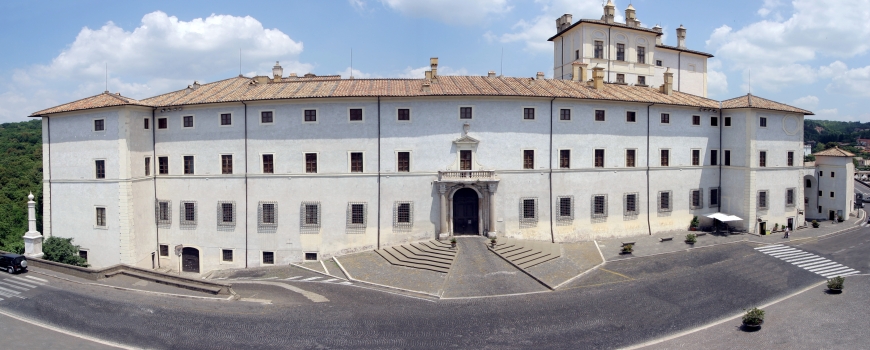The large room on the upper floor belongs to this period as shown by the fireplace in peperino rock decorated with caryatid, and by the impressive pilasters of the main entrance overlooking the courtyard.
In 1661, Ariccia was purchased by the Chigi family who undertook the new layout of the town and also renovated the Palace, Piazza della Corte (Public square) and the Chiesa dell’Assunta. Pope Alexander VII assigned the work to the mastermind of Gian Lorenzo Bernini and to his collaborator Carlo Fontana who transformed the town into a splendid Baroque style complex, completed in two phases: the first roughly between 1664 to 1672 and the second between 1740 to 1743.
The building appears as an architectural hybrid between a castle, a villa and a palace. The combination generates the stern grandeur of a towering castle, the elegance of the grey-blue colours of the Baroque Palace and the flippancy of the surrounding park. In 1988, the Palace, already in a degraded state, was sold under particular conditions, to the Town Council of Ariccia by Prince Agostino Chigi Albani della Rovere.
Today, it is a palace-museum and a centre of cultural events and has recently become home to the museum of Roman Baroque. It is possible to admire the lavish interior, the furnishings and decorations, the walls covered with leather and gold print, the ceilings, the Prince’s personal library, the dining room and the rich collection of paintings and sculptures (17th and 18th century) from the Chigi Palace in Rome, most of which are well preserved. There are paintings by Baciccio, Maratta, Salvator Rosa, Giovanni Maria Morandi, Pier Francesco Mola, Cavalier d’Arpino, Pietro da Cortona and Jacob Ferdinand Voet; sculptures by artists of the Bernini school such as Bernardo Fioriti, Orfeo Boselli and the famous bust of Pope Alexander VII by Melchiorre Caffà. Many of these works belonged to a collection donated by the historian of art Maurizio Fagiolo dell’Arco.
Among the wall decorations, we can see the well known sanguine drawing by Bernini representing San Giuseppe e il Bambino (Joseph and Child) in the chapel as well as works by Giovanni Campovecchi, Giuseppe Cades and Pietro Mulieri, also known as “Tempesta”. Among the furnishings is the outstanding “Farmacia” (Pharmacy) designed by Carlo Fontana; the two console tables designed by Bernini, both creations of Antonio Chicari, a renowned woodcarver of the Baroque Period.
The beauty of the interior, the structure and the decorations can be seen in the film “The Leopard” directed by Luchino Visconti in 1962.
There is a magnificent 16th century park outside the Palace, rich in centuries-old local vegetation as well as exotic plants such as the Sequoias, imported by the Chigi family from America. The Park was first known as Barco (open space for hunting) later, thanks to the work of Bernini and Fontana, it became a splendid picturesque garden and one of the destinations of the Grand Tour d’Italie, immortalized by artists such as Hackert, Corot, Turner, Ivanov etc. and remembered by Goethe, Stendhal and D’Annunzio. Inside the Palace, you can still admire the well preserved Uccelliera (Aviary), built by the Savelli family in 1628, as well as the monument of Tiberio Latinio Pandusa which was transferred there in 1997.


 Visit Castelli Romani
Visit Castelli Romani 

